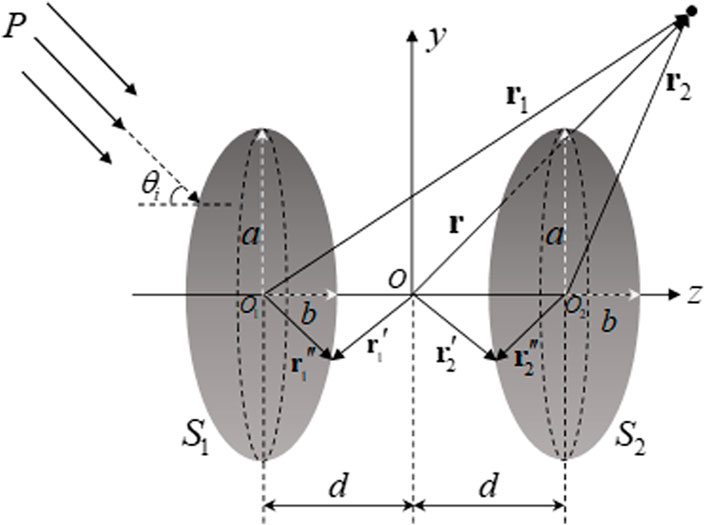- 1School of Naval Architecture and Ocean Engineering, Huazhong University of Science and Technology, Wuhan, Hubei, China
- 2School of Naval Architecture, Ocean and Energy Power Engineering, Wuhan University of Technology, Wuhan, China
- 3Hubei Key Laboratory of Naval Architecture & Ocean Engineering Hydrodynamics (HUST), Wuhan, Hubei, China
- 4Collaborative Innovation Centre for Advanced Ship and Deep-Sea Exploration (CISSE), Shanghai, China
In this study, the T-matrix method combined with the addition theorems of spherical basis functions is applied to semi-analytically compute the underwater far-field acoustic scattering of a pair of rigid spheroids with arbitrary incident angles. The involvement of the addition theorems renders the multiple scattering fields of each spheroid to be translated into an identical origin. The accuracy and convergence property of the proposed method are verified and validated. The interference of specular reflection wave and Franz wave can be spotted from the oscillations of the form function. Furthermore, the propagation paths of specular reflection and Franz waves are quantitatively analyzed in the time domain with conclusions that the Franz waves reach the observation point subsequent to specular reflection waves and the time interval between these two wave series is equal to the time cost of the Franz waves traveling along the sphere surfaces. Finally, the effects of separation distances, aspect ratios (the ratio of the polar radius to equatorial radius), non-dimensional frequencies, and incidence angles of the plane wave on the far-field acoustic scattering of a pair of rigid spheroids are studied by the T-matrix method.
1 Introduction
The study of underwater target acoustic scattering gains attentions from researchers, and the relative research studies are widely applied in engineering practices such as underwater target detection, positioning, imaging, and underwater communication. The mechanism of multiple-target acoustic scattering is more complex than that of single-target scattering due to the existence of multiple scattering. In this study, a pair of rigid spheroids is chosen as the target to investigate the multiple acoustic scattering characteristics.
In the past decades, a series of numerical and analytical methods are proposed to solve the underwater acoustic scattering problem. Numerical methods such as the finite element method (FEM) and boundary element method (BEM) can solve acoustic scattering problems under complex conditions [1–3]. Recently, various extended methods, like the smooth finite element method and meshfree method [4–7], are proposed to solve the underwater acoustic scattering issues. However, the computational efficiency of those numerical methods decreases as the frequency increases because of the requirement of very dense meshes. Compared to the numerical methods, the analytical method can provide precise solutions with a faster convergence speed. In addition, the physical understanding of the acoustic scattering wave can be explained by the analytical solutions. Rayleigh first derived the Bessel–Legendre series (mathematical) solution for the acoustic scattering of a sphere by the variable separation method. However, his works are only competent to cases with small non-dimensional frequencies
The T-matrix method, a typical semi-analytical method, is first proposed by Waterman for electromagnetic scattering problems [17] and later extended to the acoustic scattering field [18]. The T-matrix method is defined as the semi-analytical method derived from the Helmholtz integral equation and null-field theory, and the infinite matrix needs to be truncated. The crux of the T-matrix method is to expand all the field quantities by a set of orthogonal basis functions and solve the unknown expansion coefficients. In addition, the T-matrix method is suitable for the acoustic scattering problem with arbitrary incidence and scattering angles. Peterson derived the T-matrix expression for multi-target scattering based on the addition theorems of spherical basis functions and calculates the numerical result of a pair of identical spheres under the plane wave incidence [19]. Most of the published literature works focus on the acoustic scattering of a pair of spheres and spheroids with small aspect ratios (i.e., the ratio of the polar radius to equatorial radius is less than 2). However, it is important to study the acoustic scattering mechanism of a pair of rigid oblate spheroids and prolate spheroids, which are extensively used in hydrodynamics and underwater engineering.
In this work, the addition theorems are embedded in the T-matrix method to investigate the underwater far-field acoustic scattering characteristics of a pair of rigid spheroids with different aspect ratios ensonified by plane waves at different angles. The propagation paths of the returning backscattering waves from a pair of rigid spheres are analyzed by using the geometric and numerical method in the time domain. The structure of this work is as follows: In Section 2, acoustic scatterings of a single rigid spheroid are considered by the traditional T-matrix method; in addition, the addition theorems are embedded in the T-matrix method to investigate the scatterings of a pair of rigid spheroids. In Section 3, some numerical experiments are carried out to verify the accuracy and convergence of the T-matrix method for the acoustic scattering of a pair of rigid spheroids. Furthermore, the effects of the separation distance between spheroids, aspect ratios, non-dimensional frequencies, and incidence angles of the plane wave on the acoustic scattering of a pair of rigid spheroids are investigated, while conclusions are provided in Section 4.
2 T-matrix method
In this section, a rigid spheroid and a spheroid pair are considered. The acoustic scatterings of such models under plane wave incidence at an arbitrary angle are investigated using the T-matrix method.
2.1 For a rigid spheroid
As shown in Figure 1, a rigid rotation spheroid with the polar radius
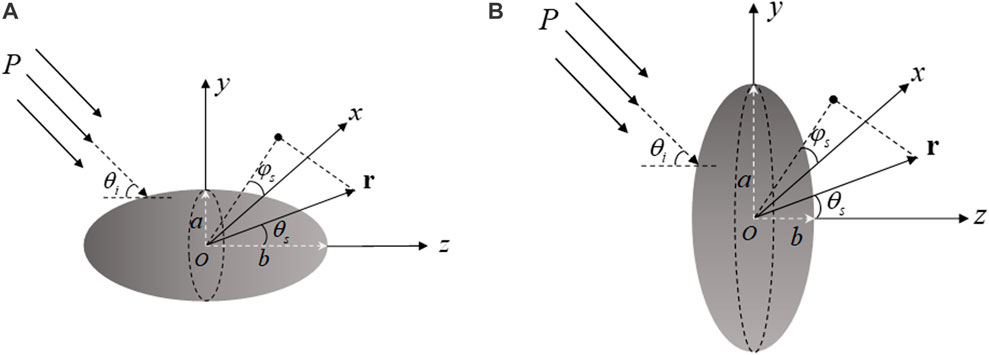
FIGURE 1. Geometry model for the acoustic scattering of a rigid (A) prolate and (B) oblate spheroid.
The entire wave field can be constructed by the scalar velocity potential because the wave field exists only in the ideal fluid medium. For convenience, in what follows, the monochromatic time factor
All of the aforementioned velocity potentials satisfy the Helmholtz equation:
where
where
The crucial point is to expand the whole field quantities with a set of orthogonal basis functions and solve the corresponding unknown coefficients. The scalar spherical basis function is expressed as
where
with
The incident and scattered field can be expanded into the form of the weighted sum of the scalar basis function with the expanded coefficients. The regular spherical basis function, denoted by
where
Furthermore, the free-field Green’s function
where
where
For a rigid spheroid, the boundary of the spheroid at
Substituting Eqs 6–13 into Eq. 4 yields
where
The detailed expression of
where
From Eqs 14, 15, the relationship between scattering and incident expanded coefficients can be expressed as
where the transition matrix
2.2 For a pair of rigid spheroids
In this part, the formula of the T-matrix method for a pair of rigid spheroids immersed in the idea fluid is derived. The geometry of the configuration to be considered is shown in Figure 2. The formula of the T-matrix method for a pair of rigid spheroids is derived exactly like Eq. 4:
The incident field
where
From Eqs 8, 21, where
The addition theorems of the spherical basis functions are used in Eqs 23, 24. The translation properties are as follows [22, 23]:
where the coordinates of the vector
where
where
In this study, the expression of the matrices
Substituting Eqs 22–25 into the second formula of Eq. 20 yields
The expansion coefficients of the unknown surface fields of two spheroids are
where
where
Considering the field point
Substituting Eqs 34, 35, 9 into the first formula of Eq. 20 yields
From Eqs 32, 33, the surface field coefficients
where I is the identity matrix and
Since the far-field scattering characteristics are majorly considered in the current study, the form function
where
3 Numerical examples and results
In this section, the convergence and accuracy of the T-matrix method for calculating the acoustic scattering of a pair of rigid spheres and spheroids are shown by several numerical experiments. Afterward, the monostatic and bistatic acoustic scattering form function modulus
3.1 Numerical validation
The convergence of the T-matrix method for calculating the acoustic scattering of a pair of rigid spheres under the plane wave end-on incidence (
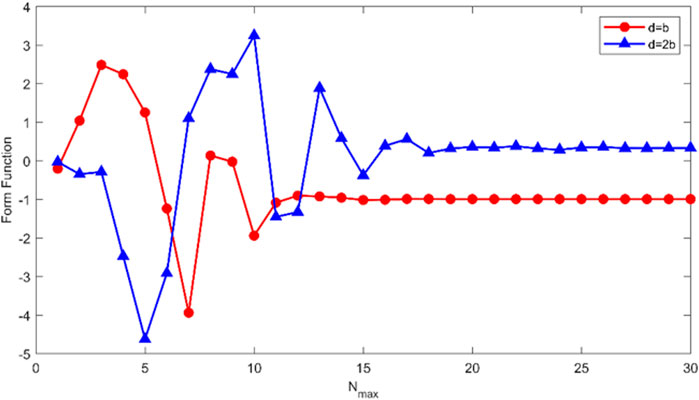
FIGURE 3. Convergence study of the T-matrix method for a pair of rigid spheres. The backscattering modulus
The truncation factor
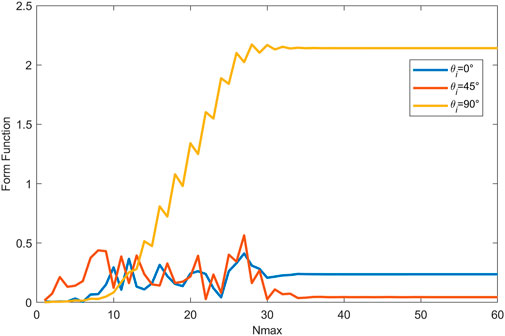
FIGURE 4. Convergence study of the T-matrix method for a pair of rigid spheroids with aspect ratio
In the following, some numerical experiment results of the acoustic scattering of a pair of rigid spheres calculated by the present method are compared with Peterson’s works [19] and the analytical results. The comparison results are shown in Figure 5. The circles are values according to the data from Peterson’s works, while the solid lines are calculated by the present method. Panel (a) of Figure 5 displays the backscattering cross section of a pair of rigid spheres at the broadside incidence case (
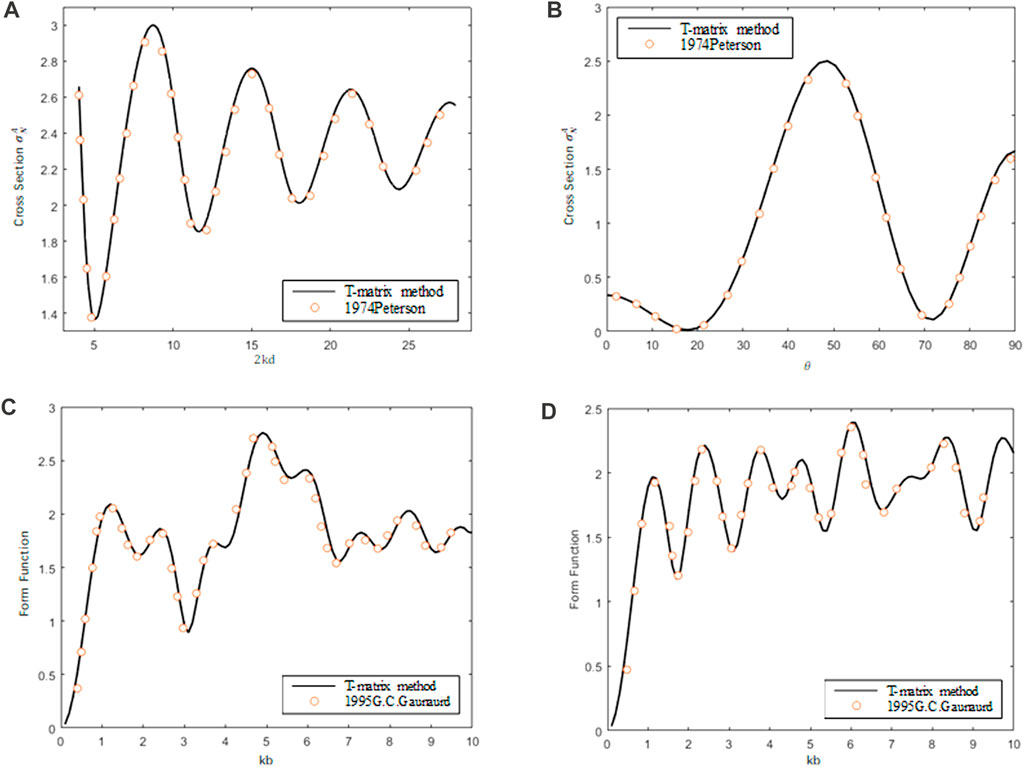
FIGURE 5. Accuracy study of the T-matrix method for a pair of rigid spheres. (A) Backscattering cross section of a pair of rigid spheres at broadside incidence (
Panel (b) of Figure 5 displays the far-field backscattering cross section
3.2 Far-field acoustic scattering properties of a pair of rigid spheres
In this part, the far-field scattering properties of a pair of rigid spheres under the plane wave at arbitrary incident angles are studied by the T-matrix method. Figure 6 displays the backscattering form function
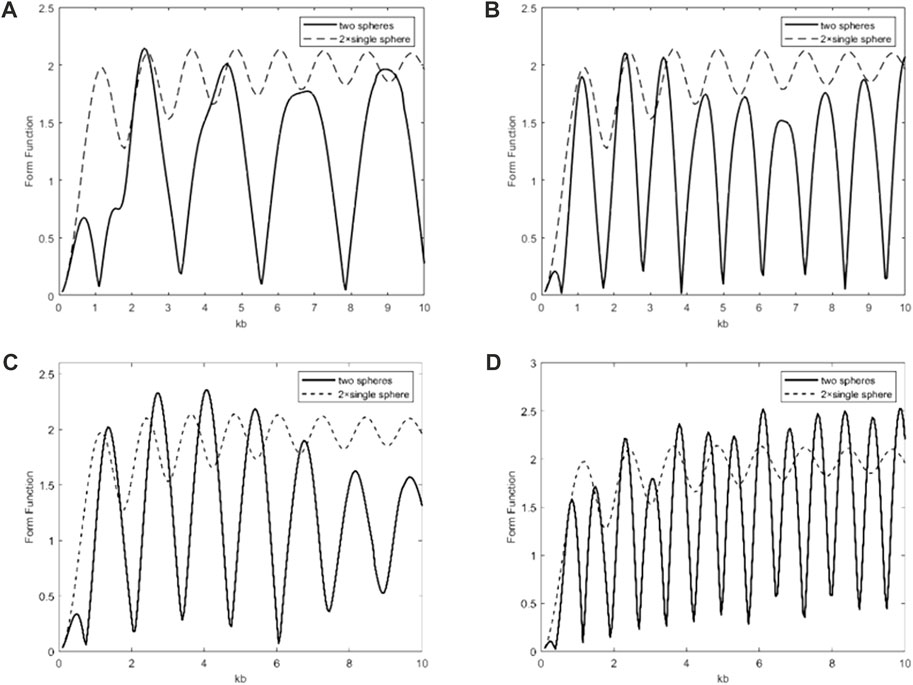
FIGURE 6. Backscattering form function
The path of backscattering waves by a pair of rigid spheres ensonified by the pulse wave from end-on incidence and oblique incidence, respectively, is shown in Panels (a) and (b) of Figure 7.
where
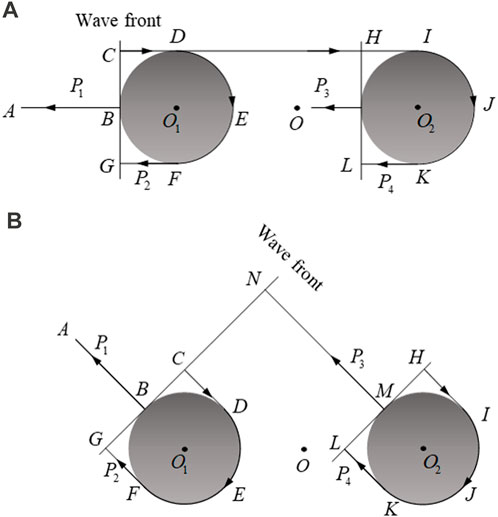
FIGURE 7. Propagation path of the backscattering waves by a pair of spheres at (A) end-on incidence and (B) oblique incidence.
The ideal fluid medium around the spheres is water. The velocity of the specular reflection wave is 1,510 m/s, and the scattering field point is located at (−30, 0). The time domain response results obtained by the inverse fast Fourier transform (IFFT) of the frequency domain response results [33] of a pair of rigid spheres at three incidence cases (
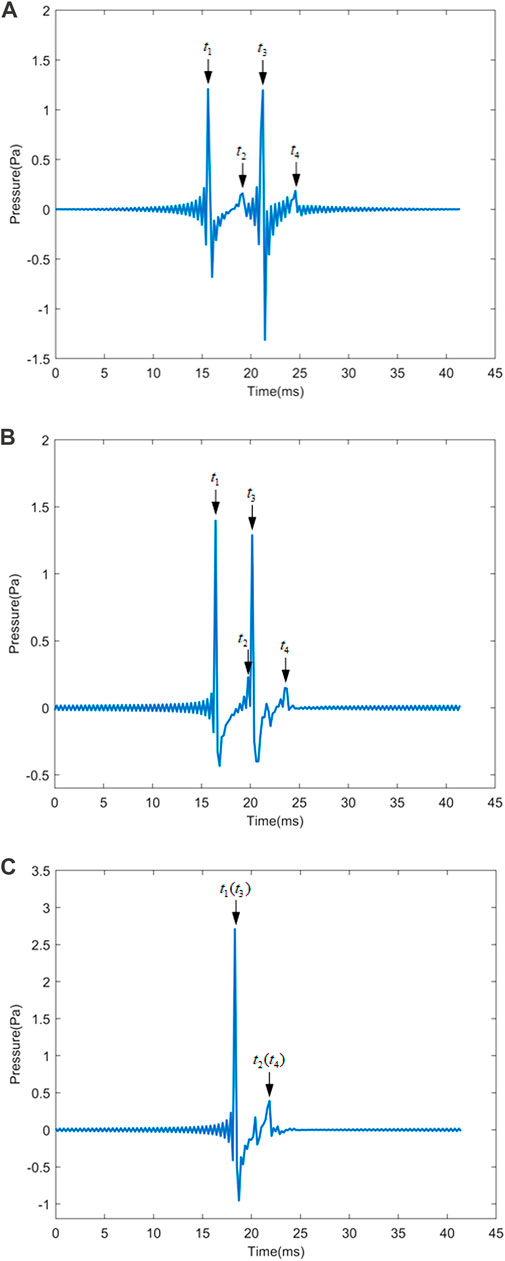
FIGURE 8. Backscattering response waves of a pair of rigid spheres in the time domain for the separation distance

TABLE 1. Time intervals regarding the peak-to-peak intervals in Panel (a) of Figure 7.

TABLE 2. Time intervals regarding the peak-to-peak intervals in Panel (b) of Figure 7.

TABLE 3. Time intervals regarding the peak-to-peak intervals in Panel (c) of Figure 7.
In order to quantitatively study the scattering of a pair of rigid spheres, the bistatic 2D directivity plots of a pair of rigid spheres under three cases (
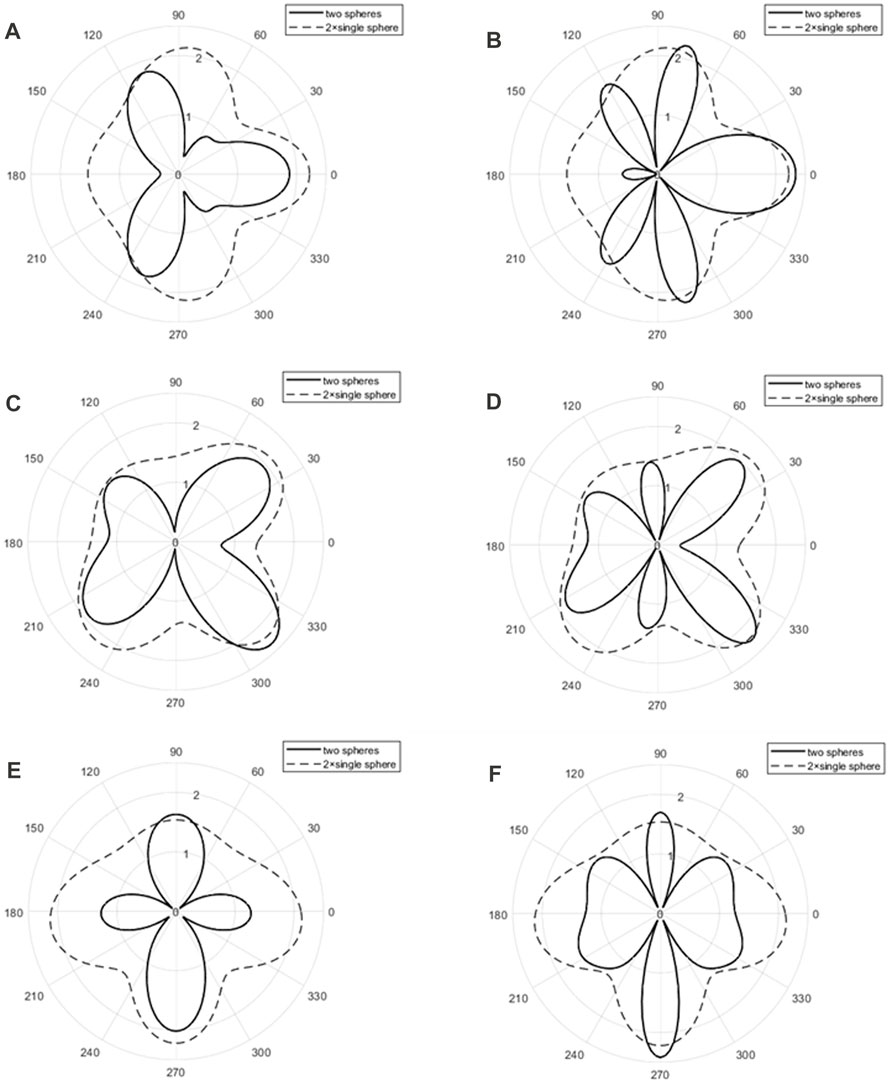
FIGURE 9. Bistatic 2D directivity pattern (solid line) of a pair of rigid spheres at end-on (
3.3 Far-field acoustic scattering properties of a pair of rigid spheroids
In this section, the far-field scattering properties of a pair of rigid spheroids under arbitrary incident angles of the plane wave are studied by the T-matrix method. The results of the backscattering form function
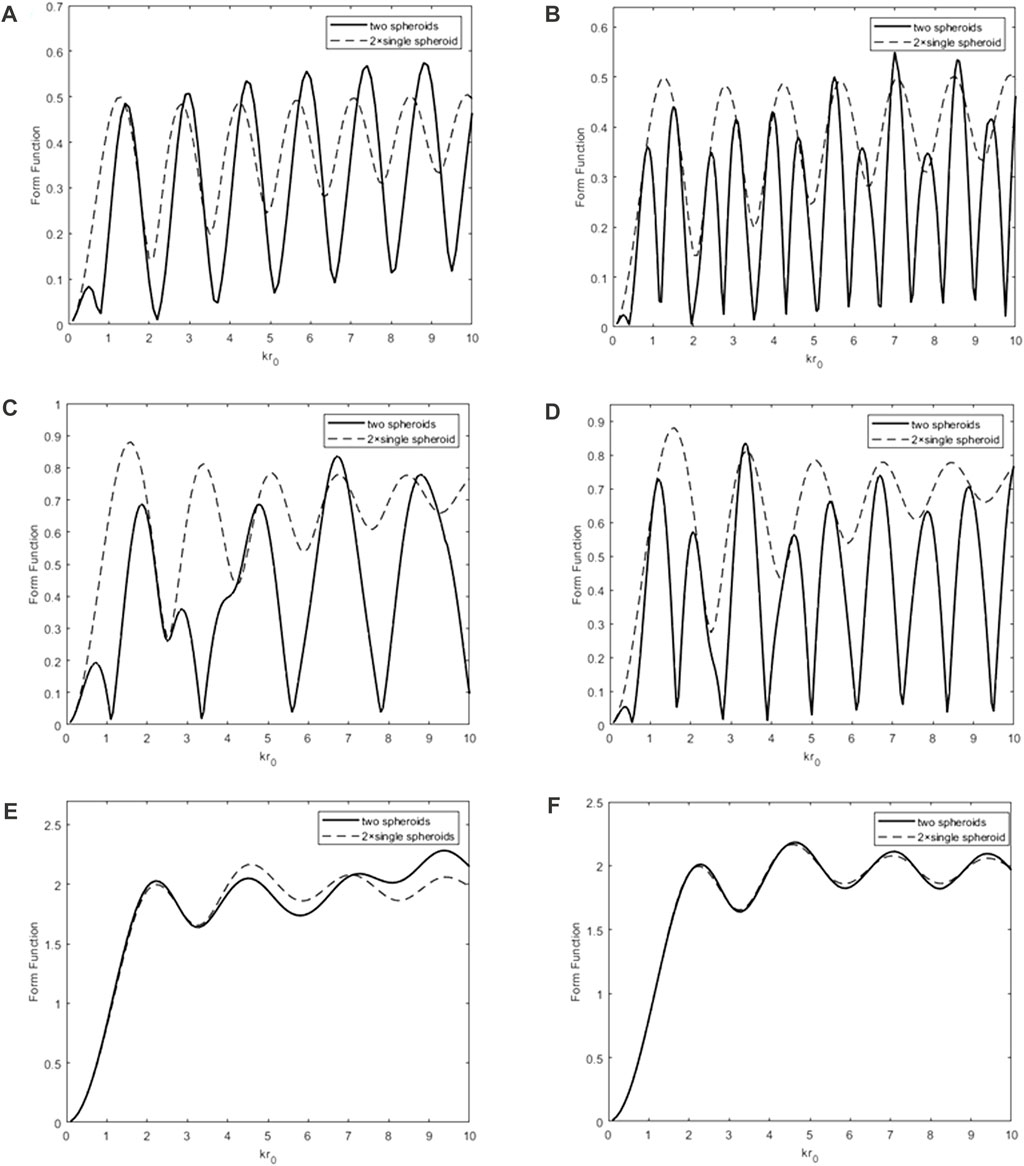
FIGURE 10. Backscattering form function
Figure 11 displays the backscattering form function
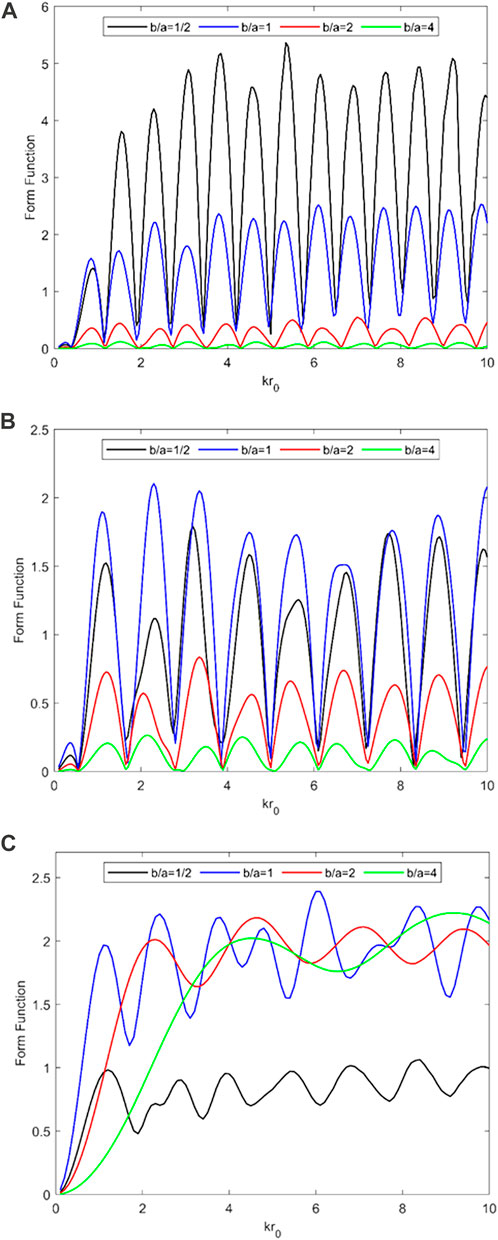
FIGURE 11. Backscattering form function
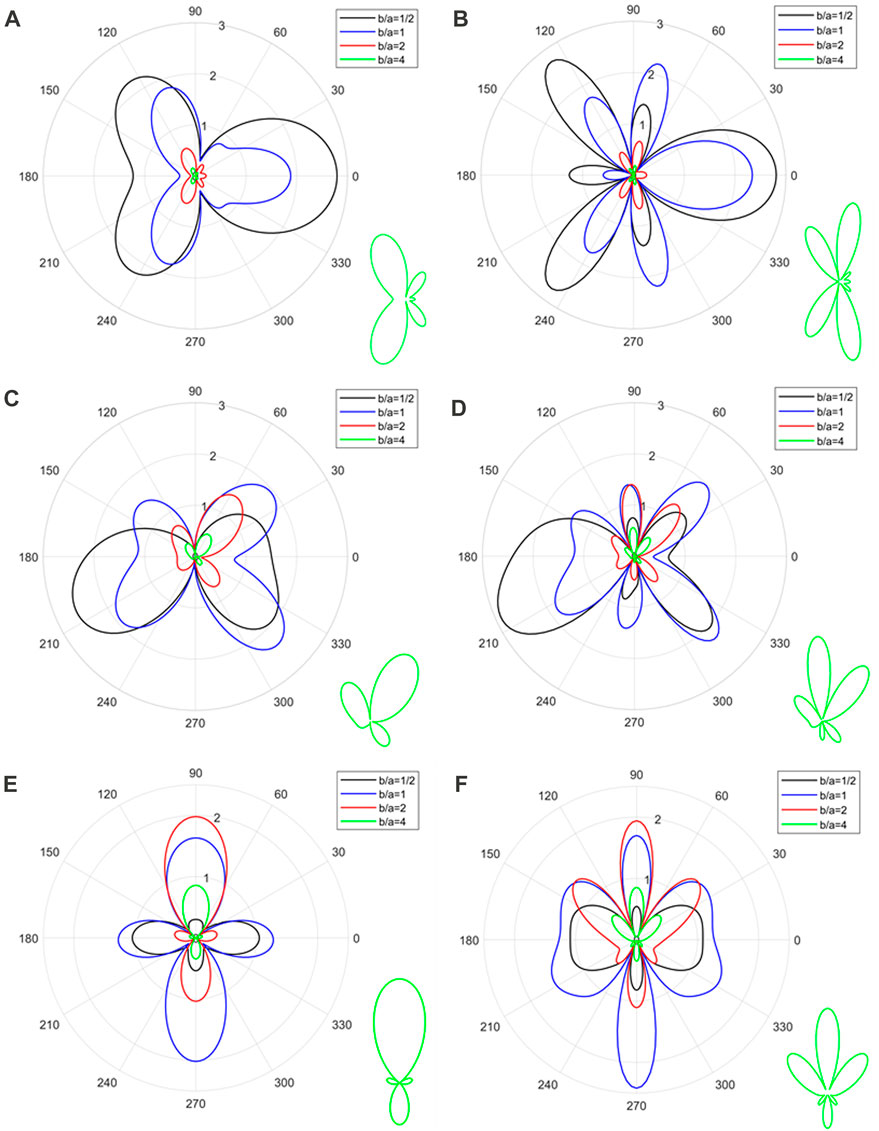
FIGURE 12. Bistatic 2D directivity pattern of a pair of rigid spheroids with different aspect ratios (
4 Conclusion
In this work, the T-matrix method combined with the addition theorems of spherical basis functions is applied to semi-analytically compute the far-field acoustic scattering of a pair of rigid spheroids under the plane wave at an arbitrary incidence angle. It is verified that the T-matrix method can accurately solve the far-field acoustic scattering problem of a pair of rigid spheres with different separation distances under the plane wave of any angle. In addition, some numerical experiments on a pair of rigid (oblate or prolate) spheroids are carried out by the T-matrix method with the following conclusions:
1) The acoustic scattering by a pair of rigid spheroids is more complicated than that of a single rigid spheroid, and the values of the scattering form function of a pair of rigid spheroids are not equal to twice the far-field scattering form function modulus of a single rigid spheroid.
2) The peak-to-peak interval of the backscattering response curve obtained by the IFFT in the time domain is consistent with the geometric prediction results, which makes it possible to estimate the geometrical dimension and separation distance of multiple scatterers from the scattering response wave.
3) The parameters affecting the far-field scattering form function modulus of a pair of rigid spheroids are aspect ratio
Data availability statement
The original contributions presented in the study are included in the article/Supplementary Material; further inquiries can be directed to the corresponding author.
Author contributions
WL conceptualized this investigation. YY performed the formal analysis and validation. YY performed the data analysis with advice from QG, YZ, YC, and WL. YY wrote the manuscript. All authors contributed to the article and approved the submitted version.
Conflict of interest
The authors declare that the research was conducted in the absence of any commercial or financial relationships that could be construed as a potential conflict of interest.
Publisher’s note
All claims expressed in this article are solely those of the authors and do not necessarily represent those of their affiliated organizations, or those of the publisher, the editors, and the reviewers. Any product that may be evaluated in this article, or claim that may be made by its manufacturer, is not guaranteed or endorsed by the publisher.
References
1. Seybert AF, Rengarajan TK. The use of CHIEF to obtain unique solutions for acoustic radiation using boundary integral equations. The J Acoust Soc America (1987) 81(5):1299–306. doi:10.1121/1.2024508
2. Hunt JT, Knittel MR, Barach D. Finite element approach to acoustic radiation from elastic structures. The J Acoust Soc America (1974) 55(2):269–80. doi:10.1121/1.1914498
3. Seybert AF, Soenarko B, Rizzo FJ, Shippy DJ. An advanced computational method for radiation and scattering of acoustic waves in three dimensions. J Acoust Soc America (1985) 77(2):362–8. doi:10.1121/1.391908
4. Chai YB, Li W, Gong ZX, Li TY. Hybrid smoothed finite element method for two-dimensional underwater acoustic scattering problems. Ocean Eng (2016) 116:129–41. doi:10.1016/j.oceaneng.2016.02.034
5. Li W, Chai YB, Lei M, Li TY. Numerical investigation of the edge-based gradient smoothing technique for exterior Helmholtz equation in two dimensions. Comput Structures (2017) 182:149–64. doi:10.1016/j.compstruc.2016.12.004
6. You X, Gui Q, Zhang Q, Chai Y, Li W. Meshfree simulations of acoustic problems by a radial point interpolation method. Ocean Eng (2020) 218:108202. doi:10.1016/j.oceaneng.2020.108202
7. Gui Q, Zhang G, Chai Y, Li W. A finite element method with cover functions for underwater acoustic propagation problems. Ocean Eng (2022) 243:110174. doi:10.1016/j.oceaneng.2021.110174
9. Faran JJ. Sound scattering by solid cylinders and spheres. The J Acoust Soc America (1951) 23(4):405–18. doi:10.1121/1.1906780
11. Záviška F. Über die Beugung elektromagnetischer Wellen an parallelen, unendlich langen Kreiszylindern. Annalen der physik (1913) 4(40):1023–56. doi:10.1002/andp.19133450511
12. Williams KL, Marston PL. Backscattering from an elastic sphere: Sommerfeld–Watson transformation and experimental confirmation. J Acoust Soc America (1985) 78(3):1093–102. doi:10.1121/1.393028
13. Eyges L. Some nonseparable boundary value problems and the many-body problem. Ann Phys (1957) 2(2):101–28. doi:10.1016/0003-4916(57)90037-4
14. Sack RA. Three-dimensional addition theorem for arbitrary functions involving expansions in spherical harmonics. J Math Phys (1964) 5:252–9. doi:10.1063/1.1704115
15. Gabrielli P, Mercier-Finidori M. Acoustic scattering by two spheres: Multiple scattering and symmetry considerations. J Sound Vibration (2001) 241(3):423–39. doi:10.1006/jsvi.2000.3309
16. Gaspard P, Rice SA. Exact quantization of the scattering from a classically chaotic repellor. J Chem Phys (1989) 90(4):2255–62. doi:10.1063/1.456019
17. Waterman PC. Matrix formulation of electromagnetic scattering. Proceeding of the IEEE (1965) 53(8):805–12. doi:10.1109/PROC.1965.4058
18. Waterman PC. New formulation of acoustic scattering. J Acoust Soc America (1969) 45(6):1417–29. doi:10.1121/1.1911619
19. Peterson B, Ström S. Matrix formulation of acoustic scattering from an arbitrary number of scatterers. J Acoust Soc America (1975) 56:771–80. doi:10.1121/1.1903325
20. Mishchenko MI. Electromagnetic scattering by particles and particle groups: An introduction. New York: Cambridge University press (2014).
21. Mishchenko MI, Hovenier JW, Tracis LD. Light scattering by nonspherical particles: Theory, measurements, and applications. Academic Press (1986).
22. Danos M, Maximon LC. Multipole matrix elements of the translation operator. J Math Phys (1965) 6(5):766–78. doi:10.1063/1.1704333
24. Edmonds AR. Angular momentum in quantum mechanics. Princeton, NJ: Princeton University Press (1974).
25. Neubauer WG, Vogt RH, Dragonette LR. Acoustic reflection from elastic spheres. I. Steady-state signals. J Acoust Soc America (1974) 55:1123–9. doi:10.1121/1.1914676
26. Dragonette LR, Vogt RH, Flax L, Neubauer WG. Acoustic reflection from elastic spheres and rigid spheres and spheroids. II. Transient analysis. J Acoust Soc America (1974) 55:1130–7. doi:10.1121/1.1914677
27. Li W, Chai YB, Gong ZX, Marston PL. Analysis of forward scattering of an acoustical zeroth-order Bessel beam from rigid complicated (aspherical) structures. J Quantitative Spectrosc Radiative Transfer (2017) 200:146–62. doi:10.1016/j.jqsrt.2017.06.002
28. Gaunaurd GC, Huang H, Strifors HC. Acoustic scattering by a pair of spheres. J Acoust Soc America (1995) 98:495–507. doi:10.1121/1.414447
29. Pillai TAK, Varadan VV, Varadan VK. Sound scattering by rigid and elastic infinite elliptical cylinders in water. J Acoust Soc America (1982) 72:1032–7. doi:10.1121/1.388234
30. Eastland GC, Marston PL. Enhanced backscattering in water by partially exposed cylinders at free surfaces associated with an acoustic Franz wave. J Acoust Soc America (2014) 135:2489–92. doi:10.1121/1.4870240
31. Gong ZX, Li W, Mitri FG, Chai YB, Zhao Y. Arbitrary scattering of an acoustical Bessel beam by a rigid spheroid with large aspect-ratio. J Sound Vibration (2016) 383:233–47. doi:10.1016/j.jsv.2016.08.003
32. Gong ZX, Li W, Chai YB, Zhao Y, Mitri FG. T-matrix method for acoustical Bessel beam scattering from a rigid finite cylinder with spheroidal endcaps. Ocean Eng (2017) 129:507–19. doi:10.1016/j.oceaneng.2016.10.043
33. Li W, Liu GR. Estimation of radius and thickness of a thin spherical shell in water using the midfrequency enhancement of a short tone burst response. J Acoust Soc America (2005) 118:2147–53. doi:10.1121/1.2040027
Keywords: T-matrix method, addition theorems, a pair of rigid spheroids, acoustic scattering, far-field form function
Citation: Yang Y, Gui Q, Zhang Y, Chai Y and Li W (2023) Acoustic scattering of a pair of rigid spheroids based on the T-matrix method. Front. Phys. 11:1170811. doi: 10.3389/fphy.2023.1170811
Received: 21 February 2023; Accepted: 17 May 2023;
Published: 02 June 2023.
Edited by:
Glauber T. Silva, Federal University of Alagoas, BrazilReviewed by:
Vladimir Rabinovich, National Polytechnic Institute (IPN), MexicoBernhard Johan Hoenders, University of Groningen, Netherlands
Copyright © 2023 Yang, Gui, Zhang, Chai and Li. This is an open-access article distributed under the terms of the Creative Commons Attribution License (CC BY). The use, distribution or reproduction in other forums is permitted, provided the original author(s) and the copyright owner(s) are credited and that the original publication in this journal is cited, in accordance with accepted academic practice. No use, distribution or reproduction is permitted which does not comply with these terms.
*Correspondence: Wei Li, aHVzdGxpd0BodXN0LmVkdS5jbg==
 Yuzheng Yang
Yuzheng Yang Qiang Gui
Qiang Gui Yang Zhang
Yang Zhang Yingbin Chai2
Yingbin Chai2 Wei Li
Wei Li